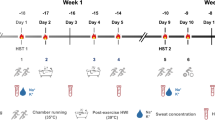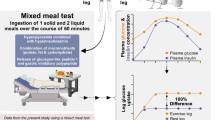Abstract
Purpose
The purpose of this study was to examine the effects of reductions in blood volume and associated oxygen-carrying capacity on the incidence of plateau at \(\dot{V}{\text{O}}\) 2max.
Methods
Fifteen well-trained athletes (age 23.3 ± 4.5; mass 77.4 ± 13.1 kg, height 180.1 ± 6.0 cm) completed three incremental cycle tests to volitional exhaustion, of which the first was defined as familiarisation, with the remaining two trials forming the experimental conditions of pre- (UBL) and post-(BLE) blood donation (~450 cm3). The work rate for the incremental tests commenced at 100 W for 60 s followed by a ramp of 0.42 W s−1, with cadence being held constant at 80 rpm. Throughout all trials, \(\dot{V}{\text{O}}\) 2 was determined on a breath-by-breath basis using a pre-calibrated metabolic cart. The criteria for plateau determination was a ∆\(\dot{V}{\text{O}}\) 2 ≤ 50 ml min−1 over the final two consecutive 30 s sampling periods.
Results
Despite a significant (P = 0.0028) 9.4 % reduction in haemoglobin concentration and 10.8 % (P = 0.016) reduction in erythrocyte count between UBL and BLE, there was no change in plateau incidence. However, significant differences were observed for both \(\dot{V}{\text{O}}\) 2max (P = 0.0059) 51.3 ± 7.6 (UBL) 48.4 ± 7.9 ml kg−1 min−1 (BLE) and gas exchange threshold arrival time 383.4 ± 85.2 s (UBL) 349.2 ± 71.4 s (BLE) (P = 0.0028).
Conclusion
These data suggest that plateau at \(\dot{V}{\text{O}}\) 2max is unaffected by O2 availability lending support to the notion of the plateau being dependent on the anaerobic capacity and the classically orientated concept of \(\dot{V}{\text{O}}\) 2max.
Similar content being viewed by others
References
Astorino TA (2009) Alterations in VO2max and the VO2 plateau with manipulation of sampling interval. Clin Physiol Funct Imaging 29:60–67
Astorino T, White A (2010) Assessment of anaerobic power to verify VO2max attainment. Clin Physiol Funct Imaging 30:294–300
Astorino TA, Robergs R, Ghiasvand F, Marks D, Burns S (2000) Incidence of the oxygen plateau at VO2max during exercise testing to volitional fatigue. J Exerc Physiol 3:1–12
Burnley M, Roberts C, Thatcher R, Doust JH (2006) Influence of blood donation on O2 uptake on-kinetics, peak O2 uptake and time to exhaustion during severe-intensity exercise. Exp Physiol 91:499–509
Chatard JC, Mujika I, Guy C, Lacour JR (1999) Anaemia and iron deficiency in athletes. Sports Med 27:229–240
Doherty M, Nobbs L, Noakes T (2003) Low frequency of the “plateau phenomenon” during maximal exercise in elite British athletes. Eur J Appl Physiol 89:619–623
Ekblom B, Goldberg AN, Gulbring B (1972) Response to exercise after blood loss and reinfusion. J Appl Physiol 33:175–180
Freedson PS (1981) The influence of haemoglobin (concentration) on exercise cardiac output. Int J Sports Med 2:81–86
Freidmann B, Frese F, Menold E, Bartsch P (2007) Effects of acute moderate hypoxia on anaerobic capacity in endurance-trained runners. Eur J Appl Physiol 101:67–73
Gastin P (2001) Energy system interaction and relative contribution during maximal exercise. Sports Med 31:725–741
Gledhill N (1982) Blood doping and related issues: a brief review. Med Sci Sports Exerc 14:183–189
Gledhill N (1985) The influence of altered blood volume and oxygen transport capacity on aerobic performance. Exerc Sports Sci Rev 13:75–93
Gledhill N, Cox D, Jamnik R (1994) Endurance athletes’ stroke volume does not plateau: major advantage is diastolic function. Med Sci Sports Exerc 26:1116–1121
Gordon D, Marshall K, Connell A, Barnes RJ (2010) Influence of blood donation on oxygen uptake kinetics during moderate and heavy intensity cycle exercise. Int J Sports Med 31:298–303
Gordon D, Hopkins S, King C, Keiller D, Barnes R (2011) Incidence of the plateau at VO2max is dependent on the anaerobic capacity. Int J Sports Med 32:1–6
Gordon D, Schaitel K, Pennefather A, Gernigon M, Keiller D, Barnes R (2012a) The incidence of plateau at VO2max is affected by a bout of prior-priming exercise. Clin Physiol Funct Imaging 32:39–44
Gordon D, Mehter M, Gernigon M, Caddy O, Keiller D, Barnes R (2012b) The effects of exercise modality on the incidence of plateau at VO2max. Clin Physiol Funct Imaging. doi:10.1111/j.1475-097X.2012.01142
Hawkins MN, Raven PB, Snell PG, Stray-Gunderson J, Levine BD (2007) Maximal oxygen uptake as a parametric measure of cardiorespiratory capacity. Med Sci Sports Exerc 39:103–107
Hill AV, Lupton H (1923) Muscular exercise, lactic acid and the supply and utilisation of oxygen. Q J Med 16:135–171
Horstman DH, Gleser M, Wolfe D, Tryon T, Delehunt J (1974) Effects of haemoglobin reduction on VO2max and related heamodynamics in exercising dogs. J Appl Physiol 37:97–102
Howley ET, Bassett D, Welch HG (1995) Criteria for maximal oxygen uptake: review and commentary. Med Sci Sports Exerc 27:1292–1301
Jones A, Carter H (2000) The effect of endurance training on parameters of aerobic fitness. Sports Med 29:373–386
Jones AM, Poole DC (2005) Oxygen uptake dynamics: from muscle to mouth—an introduction to the symposium. Med Sci Sports Exerc 37:1542–1550
Krip B, Gledhill N, Jammik V, Warburton D (1997) Effect of alterations in blood volume on cardiac function during maximal exercise. Med Sci Sports Exerc 29:1469–1476
Levine BD (2008) VO2max: What do we know, and what do we still need to know? J Physiol 586:25–34
McCole SD, Davis AM, Fueger PT (2001) Is there a dissociation of maximal oxygen consumption and maximal cardiac output? Med Sci Sports Exerc 33:1265–1269
Mitchell JH, Sproule BJ, Chapman CB (1958) The physiological meaning of the maximal oxygen intake test. J Clin Invest 37:538–547
Poole DC, Barstow TJ, McDonough P, Jones AM (2008) Control of oxygen uptake during exercise. Med Sci Sports Exerc 40:462–474
Schmidt W, Prommer N (2010) Impact of alterations in total haemoglobin mass on VO2max. Exerc Sports Sci Rev 38:68–76
Shephard RJ, Allen C, Benade AJS, Davies CTM, di Prampero PE, Hedman R, Merriman JE, Myhre K, Simmons R (1968) The maximum oxygen intake: an international reference standard of cardiorespiratory fitness. Bull World Health Organ 38:757–764
Spriet LL, Gledhill N, Froese AB, Wilkes DL (1986) Effect of graded erythrocythemia on cardiovascular and metabolic responses to exercise. J Appl Physiol 61:1942–1948
Sproule B, Mitchell J, Miller W (1959) Cardiopulmonary physiological responses to heavy exercise in patients with anaemia. J Clin Invest 39:378–388
Taylor HL, Buskirk E, Henschell A (1955) Maximal oxygen intake as an objective measure of cardio-respiratory performance. J Appl Physiol 8:73–80
Volkov NIE, Shirkovets EA, Borilkevich VE (1975) Assessment of aerobic and anaerobic capacity of athletes in treadmill running tests. Eur J Appl Physiol Occup Physiol 34:121–130
Wagner PD (2000) New ideas on limitations to VO2max. Exerc Sports Sci Rev 28:10–14
Wang EV, Solli GS, Nyberg SK, Hoff J, Helgerud J (2012) Stroke volume does not plateau in female endurance athletes. Int J Sports Med 33:734–739
Wasserman K (1997) Diagnosing cardiovascular and lung pathophysiology from exercise gas exchange. Chest 112:1091–1101
Yip R, Johnson C, Dallman P (1984) Age-related changes in laboratory values used in the diagnosis of anaemia and iron deficiency. Am J Clin Nutr 39:427–436
Zhou B, Conlee RK, Jensen R, Fellingham GW, George JD, Fisher GA (2001) Stroke volume does not plateau during graded exercise in elite male distance runners. Med Sci Sports Exerc 33:1849–1854
Conflict of interest
The authors declare that they have no conflict of interest.
Author information
Authors and Affiliations
Corresponding author
Additional information
Communicated by Carsten Lundby.
Rights and permissions
About this article
Cite this article
Gordon, D., Wood, M., Porter, A. et al. Influence of blood donation on the incidence of plateau at \( \dot{V}{\text{O}} \) 2max . Eur J Appl Physiol 114, 21–27 (2014). https://doi.org/10.1007/s00421-013-2743-3
Received:
Accepted:
Published:
Issue Date:
DOI: https://doi.org/10.1007/s00421-013-2743-3




